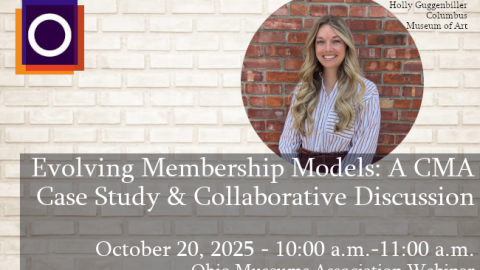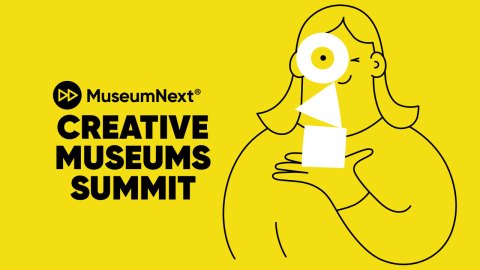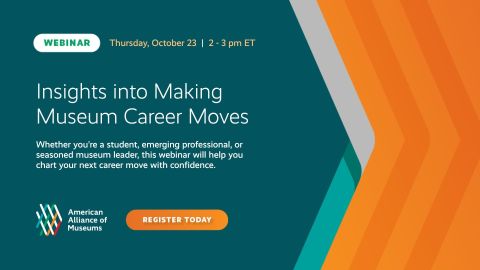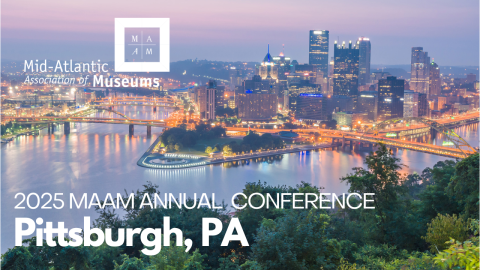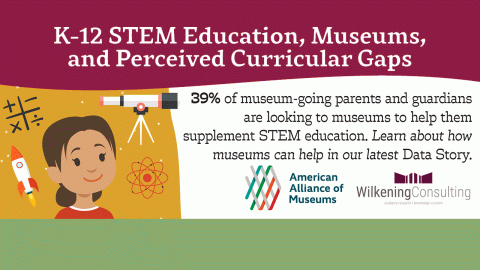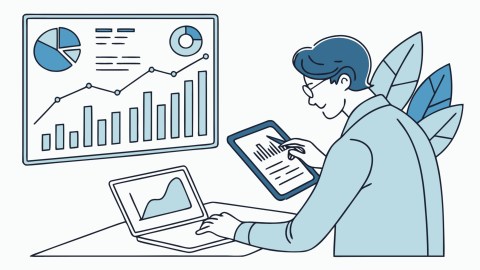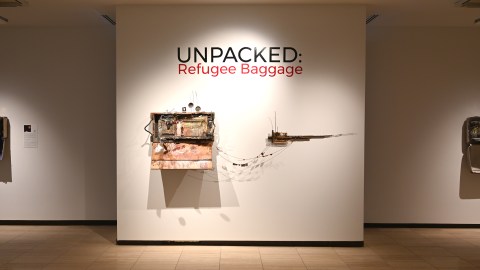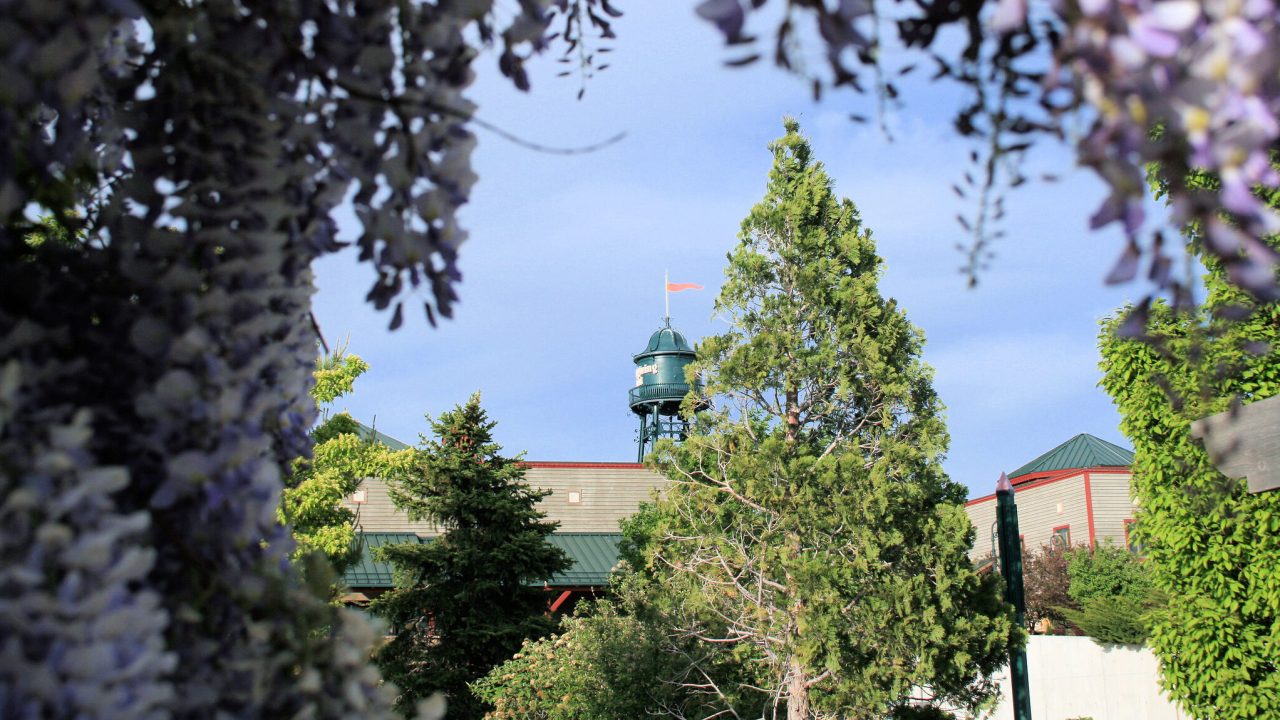
At Thanksgiving Point Institute—a farm, garden, and museum complex in Lehi, Utah—we’ve been wondering how visitor agendas are changing during the current health crisis. Understanding visitor motivations informs our efforts to be inclusive and relevant, and we believe the current social, political, and pandemic conditions are creating new paradigms that call for a reevaluation of visitor needs and how we serve them.
Several large national studies have been conducted to understand museum visitors in the time of COVID, such as those by LaPlaca Cohen and Slover Linett, Morey Consulting, IMPACTS Experience, and Wilkening Consulting on behalf of AAM. These studies are important resources for understanding national trends, but at the same time, each museum, and each community it serves, is unique. COVID case rates, mandates, and attitudes toward safety precautions differ regionally within the US (Desmon, 2020) and will necessarily inform when we open, how we open, and what communication strategies we use around opening. With that in mind, at Thanksgiving Point we have felt it is important to supplement the lessons from the national data with local data on our specific visitors.
Building on our work over the past eight years to track our visitors’ motivations and agendas on an ongoing basis, we have been using three different tools during the pandemic: a pre-opening survey of visitor needs, a weekly exit survey, and observations of visitors in galleries compared to parallel data collected pre-pandemic.
The findings have been surprising. While we expected there to be significant differences in visitors’ behavior and motivation pre- and post-pandemic, we have discovered that they are interested in reengaging with familiar places and in familiar ways, perhaps to find a sense of connection and normalcy in an abnormal time. Some of our findings stand in contrast to assumptions and even findings in national discussions, emphasizing the need for local data to understand local needs.
Pre-Opening Surveys
In preparation for reopening in April 2020, we sent a survey to membership holders and a random sample from our general mailing list. The goal of the survey was to explore pandemic-related needs our visitors might have that Thanksgiving Point could contribute to meeting, and thus position ourselves to support healing and thriving in the community.
The more than seventy-five hundred responses confirmed that our visitors highly value Thanksgiving Point as a place to spend time with others, and that having a place to deepen relationships with family and friends was the most important role they needed us to play—more than providing a place for conversation and dialogue or offering structured wellness programs.
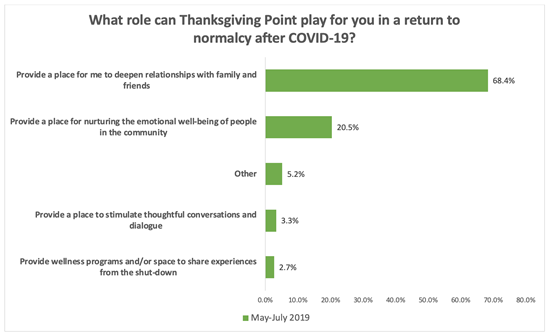
Later in the survey, we provided visitors a space to tell us “anything else” on their mind about reopening. From these, a clear pattern emerged confirming the appeal of having a place to deepen relationships with family and friends. Here are a few examples:
“It would provide peace for my family to walk through the gardens and enjoy the outdoors.”
“We really have gained a new perspective on the important things we do together as a family and we really miss the experiences we have shared and the venues that we get to explore at Thanksgiving Point. I know this has been a crazy time for everyone and we are excited to feel some sort of normalcy again and can’t wait to visit. Especially the gardens.”
“I have missed the gardens during this time. They are a place I go for my own emotional wellbeing as well as taking family and friends. I have missed going and life will definitely feel more normal once we can go back.”
The social nature of museum visits has been well studied, and considering the isolating impact of COVID-19, it is no surprise that relationships are at the center of hopes for a visit. At the same time, these visitor responses suggest another trend: Thanksgiving Point venues provided a place of refuge and escape even before the pandemic, and visitors yearned for that now more than ever. This trend is also appearing in our ongoing exit surveys.
Exit Surveys
Since 2012, Thanksgiving Point has conducted a monthly exit survey of visitors to our five venues. This ongoing practice provides us with a dashboard of what’s going well and what needs attention—perhaps more important now than ever to know.
One question we use explores visitor motivations for coming, with response options inspired by Falk’s (2009) identity-related motivations. Among the various identities, rechargers—visitors with “the yearning to physically, emotionally, and intellectually recharge in a beautiful and refreshing environment” (Falk, 2009, p. 64)—have historically been common at Thanksgiving Point’s gardens, but minimal in our other venues. However, since reopening after COVID-related shutdowns, we have seen a significant upward trend in this motivation across all venues.
The chart below compares responses from our first two months of being reopened to the same two-month period in 2019 across all venues combined. (Understanding that motivations can be multiple, even during a single visit, visitors can select up to two identities in the survey question. As such, the sum of percentages in the chart will exceed 100 percent.)
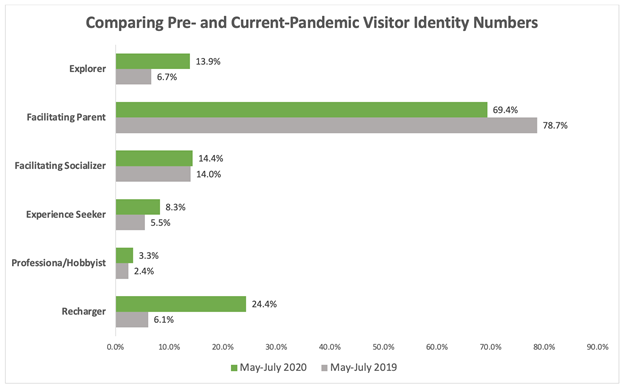
While visitors still most commonly have the goal of providing a meaningful experience for the children they bring, that rate did drop slightly. We speculate this is because of the interactive nature of many of our exhibit spaces and concerns about surface transmission of the virus.
Most interesting to us, though, is the 400 percent increase in visitors with the goal of recharging physically, emotionally, or spiritually. From May 18 to July 18 of 2019, 6.1 percent of visitors selected this response, but over the same period in 2020 that number jumped to 24.4 percent. As we might expect, visitors appear to be looking for ways to find relief from the stresses of current events and are hoping that museums can provide that.
Gallery Observations
As a final approach to understanding visitors during re-opening, we conducted tracking and timing studies in three different galleries. We wanted to know if visitors’ behaviors were different in COVID-related conditions, and how limitations might be impacting their experience.
We had conducted timing and tracking studies prior to the pandemic as part of regular efforts to understand stay times, visitation patterns, and learning behaviors. With that data in hand, between May-October 2020 we conducted the studies again to explore how these might differ under pandemic conditions. Considering the unobtrusive nature of observations, we did not need to adjust our methods.
We conducted these comparison studies at two Thanksgiving Point museums: in a paleontology exhibit hall at the Museum of Ancient Life and in the Kidopolis Gallery at the Museum of Natural Curiosity. We thought visitors might spend more time at the exhibits, because it had been a while since they had been able to attend a museum, they were looking for “escape,” or because museum admission was limited and there would be fewer people in the galleries. However, we found no significant differences, despite adjustments and safety precautions imposed by the pandemic. Visitors are staying similar amounts of time, making a similar number of stops, and engaging with the exhibits similarly to how they would at any time. In surveys visitors expressed a desire for “normalcy,” and their gallery visits suggest they are behaving accordingly.
Implications
As we adapt to rapidly changing conditions, museums are asking, what role can we play to support healing in our community? Understanding visitor agendas can shed insights on that question. In a December 2020 “Data Story,” Wilkening Consulting concluded that, on a national scope, respite is not a straightforward thing that museums can provide in this moment. Yet findings from these three approaches in visitor studies at Thanksgiving Point suggest that our local visitors are turning to our museums for much-needed relief from the stress and challenges associated with COVID-19. The responses to the open-ended survey questions, and the unchanged behavior during gallery observations, lead us to believe the “normalcy” of a museum visit is part of that relief. With this in mind, we have tried to welcome visitors with an extra measure of warmth and service that shows even through masked faces. We have also used our findings to advocate for staying open—we feel we are providing needed relief for our visitors during this challenging time. While we rely on national data to guide us in best practices for a safe reopening and inspire us with innovative approaches, local data helps us stay relevant and responsive to our visitors’ needs.
In a recent special issue of the Museum & Society journal focused on museums’ first responses to COVID-19, editor Amy Levin noted that almost none of the more than fifty submissions received focused on COVID-19 as a physical disease. Instead, she says, most “explored the epidemic as a social, psychological, economic, and cultural phenomenon in the context of a simultaneous popular uprising against racism” (Levin, 2020). In some ways, the emotional repercussions of the pandemic and concurrent social fractures have been equally as notable as the health crisis itself, even for those who have not contracted the disease.
Connecting and recharging are not mutually exclusive. In fact, the relationships we form with other people are vital to our mental and emotional wellbeing, and really, our survival (Northwestern Medicine, n.d.). Even during times of isolation, we must commit to helping each other. We suggest that museums everywhere can provide this kind of critical respite to visitors navigating their way through current social, political, and pandemic issues.
References
- Desmon, S. (2020). Regional Divide Found in COVID-19 Prevention Behaviors in United States, India. Retrieved 20 January 2020, from https://ccp.jhu.edu/2020/10/14/covid19-prevention-behaviors-united-states-india-dashboard/.
- Falk, J. (2009). Identity and the Museum Visitor Experience. Left Coast Press. Walnut Creek, CA.
- Kist, C. (2020). Museums, challenging heritage, and social media during COVID-19. Museum and Society, 18(3), 345-348.
- Levin, A. (2020). ‘Isolation as a collective experience’: Museums’ first responses to COVID-19. Museum and Society, 18(3), 295-297.
- Northwestern Medicine. (n.d.). Five Benefits of Healthy Relationships. Retrieved November 18, 2020, from https://www.nm.org/healthbeat/healthy-tips/5-benefits-of-healthy-relationships.
